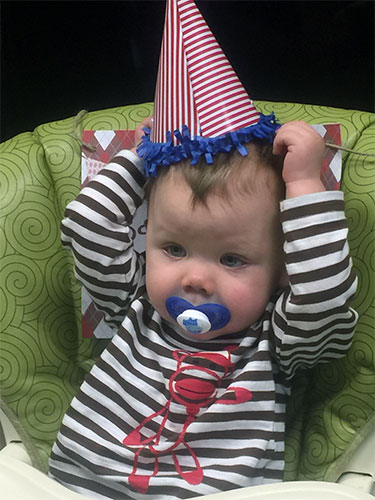 He laughs, he plays and he cries. He can sit up on his own, and he’s trying his best to crawl.
He laughs, he plays and he cries. He can sit up on his own, and he’s trying his best to crawl.
Jeremiah James Burford, or Baby JJ as he is known by many, is thriving as he celebrates his first year of life after enduring two surgeries at Children’s of Alabama in 2015 for hypoplastic left heart syndrome, a rare syndrome where the left side of the baby’s heart does not develop in the uterus, and cannot pump oxygen-rich blood to the body properly after birth.
“He’s meeting his developmental goals slowly but surely, and overall, he’s doing great,” said Crystal Burford, Baby JJ’s mother, from their home in Trussville, Alabama. “The surgeries put him a little bit behind, but to see where he has been and what he has gone through in the past year and be where he is now? He’s our little miracle.”
The Burfords, their family, friends — and even some caregivers from Children’s — all celebrated Baby JJ’s birthday Saturday, April 9, at the Trussville Civic Center.
Crystal and her husband, James, learned that JJ had a problem with his heart when she was pregnant and at the doctor for her five-month ultrasound, which was performed near Thanksgiving 2014. They were referred to the University of Alabama at Birmingham’s Department of Obstetrics and Gynecology. UAB Physicians in the Division of Maternal-Fetal Medicine confirmed the diagnosis of HLHS, a condition that affects 960 babies born in the United States each year. JJ was born April 8, 2015, at the UAB Women and Infants Center and was transferred to Children’s of Alabama a few hours later.
Robert Dabal, M.D., associate professor of surgery at UAB and section head of the Division of Pediatric Cardiac Surgery at Children’s of Alabama, says the diagnosis of the condition prior to JJ’s birth enabled the family and medical team to closely monitor him until his birth and lay the groundwork for the care he would need at that time.
“One of the great things about JJ’s case is that he was diagnosed prenatally, and we think that’s such an important step in ensuring the baby is going to do well long-term,” Dabal said. “When you know the fetus has hypoplastic left heart syndrome prior to birth, it gives the family time to plan to be ready, because it is a life-changing event. And it allows us the time to prepare. We have a fetal care team that plans everything up to the point of delivery and beyond so we can ensure the baby does very well from the moment he or she is born through the first few stages of care.”
The National Center for Biotechnology Information, an arm of the National Institutes of Health, says HLHS is one of the most challenging congenital heart defects to address. Although treatments for HLHS have improved in recent years, there is no cure. Nationwide, only 67 percent of babies born with HLHS survive to age 1.
Babies born with HLHS must undergo three different heart procedures within the first four to five years of life. The surgeries are known as the Norwood, bidirectional Glenn and the Fontan. Dabal says Children’s of Alabama surgeons operate on approximately 10 babies a year with HLHS — a number that has been pretty stable for the past five years. Dabal says the survival rate for children who have had the Norwood procedure at Children’s over the past year is 100 percent.
“The results are getting better all the time, and when you get past 1 year of age, the odds of surviving a lot longer are very good,” Dabal said.
Dabal said JJ is currently “doing great” and is on schedule to have his third and final heart procedure — the Fontan — sometime between the ages of 3 and 4.
“We really could not ask for things to have gone better than they have,” Crystal said. “JJ is just such a big part of our family. We can’t live without him. And, really, the most hilarious thing is seeing how his brother, Isaac, and sister Lilly are with him. They are just crazy about him. There is no jealousy of him. We love him with all our hearts.”